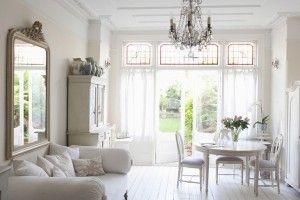 Today’s homebuyers want big, open spaces. However, older homes typically sport smaller rooms with minimal storage space. If you’re currently trying to sell a boxy, older home, you may be struggling with how to maximize your space to increase buyer interest. Here are seven ways to create the illusion of a bigger home without taking on a major renovation.
Today’s homebuyers want big, open spaces. However, older homes typically sport smaller rooms with minimal storage space. If you’re currently trying to sell a boxy, older home, you may be struggling with how to maximize your space to increase buyer interest. Here are seven ways to create the illusion of a bigger home without taking on a major renovation.
LESS IS MORE. You’ve heard it before and you’ll hear it again in relation to staging a home for sale – declutter. This is especially true of smaller houses, where you have to be particularly ruthless in minimizing what’s in each room. That means unnecessary furniture, books and objects all need to go — or at least go into storage. Keeping just enough furniture to suggest the purpose of a room is a key to staging small houses. Sometimes, sellers of homes with small rooms that spill into each other go so far as removing the doors between rooms to create a feeling of flow. And don’t make the mistake of pushing what furniture you do keep against the walls – “float” pieces in the room to create obvious walkways and a sense of easy movement from room to room.
LOSE THE WINDOW TREATMENTS. Nothing makes a room, or a whole house, feel closed-in and cramped like complicated drapes or curtains that impart a sense of claustrophobia. While your rooms may feel naked stripped of window treatments, what potential homebuyers will experience is light, air, space and a sense of the outdoors.
THINK ABOUT VISUAL PERSPECTIVE. Drawing the eye to a far distant object is a designer’s trick to create a sense of size. Consider hanging a compelling piece of wall art or photography on a far wall in an adjacent room, so that the eye has to travel to it. Or use the outdoors – pretty plantings or a beautiful tree visible through a window – to do the same thing. Perspective and vistas create a sense of space and distance.
YES, MIRRORS WORK. Strategically hanging a mirror, or even mirroring an entire wall, is a tried-and-true method for “visually doubling” the space in a room – it’s so effective it’s become a cliché, but it does the job. Just remember that if your rooms are full of “stuff,” mirrors can be a double-edged sword. They will effectively magnify the clutter as well as the space — which defeats the purpose.
THINK “TRANSPARENT.” Anything in a smaller home that “stops the eye” will make the home look smaller still, so think “see-through.” A glass or Plexiglass® coffee table is better than brown wood. Spare and streamlined table and chair legs are better than those covered with tablecloths, skirts, ruffles or flounces. Simple glass vases and accent pieces are preferable to stacks of books or busy knick-knacks. A light, airy feel is what you’re after.
LIGHT-COLORED WALLS ARE BEST. If you’re repainting before listing your smaller home – always a good idea – go with light-colored walls: creams, light grays, even very pastel blues and greens. These colors reflect daylight best, resulting in a brighter, open feel – whereas dark paint colors absorb light. While you’re at it, paint trim and moldings bright-white, which will make the walls themselves seem to recede farther into the distance.
DRAW THE EYE UPWARD. Remember, vertical space counts as space! Consider highlighting the vertical space in a room with newly painted ceilings, simple but sophisticated ceiling light fixtures, chandeliers or pendants — even ceiling-height bookcases along one wall. All of these are reasons for potential buyers to look up, appreciating a smaller home’s vertical, as well as its horizontal, space.
Builders of new houses are creating ever-larger homes, and American homebuyers are becoming accustomed to getting more and more space for their dollar. That’s why sellers of smaller and more modest traditional homes – which have their own appeal to many — have to be creative in making their homes seem spacious. Doing so will both ensure a sale and maximize the selling price.

